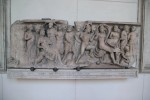| Image search results - "Hephaestus" |

BCC CG24 Oil Lamp FragmentDecorated Oil Lamp Discus?
Caesarea Maritima
1st-2nd Century CE?
Fragment of an Early Roman oil lamp?
Terracotta fragment in high relief, bearing
the profile of a old man? with beard and
moustache. He has somewhat exaggerated
facial features and wears a distinctive
head covering. The underside shows traces
of a fingerprint and a smear where the clay
was pressed into the mold. Perhaps Silenus,
Hephaestus, or an actor, priest, or merchant,
any ideas would be appreciated.
Fabric: Medium fine grained, light tan clay with
red slip. Manufacture: Mould made.
Origin: N. Africa? or Italy?
Dimensions: 3.0 x 2.7 x 0.65cm. Weight: 3.64gm.
Surface find Caesarea Maritima, 1971
J. Berlin Caesarea Collection
(click for larger pic)v-drome
|
|

Bronze quadrans, 81-161 AD, obv diademed and draped bust of Venus, rev dov stand right, S-C flanking across fieldMy first auction win! I'm very much all about deity, and am definitely planning to collect for the Greek and Roman deities if I can. Some near and dear to my heart, from preliminary scanning, I think will be hard to find (Hephaestus/Vulcan, I'm looking at you beautiful), but I'm happily determined. As to this particular coin, I cannot be happier to be starting out with Venus as my first coin, and first forum coin to boot!EvaJupiterSkies
|
|

Greece, Athens - Temple of Hephaestus and Athena Erganealso Theseion
Temple was used as church in christian times.J. B.
|
|

Greece, Bassae - Temple of Apollo Epikurosbuilt 450 - 400 BC
designed by Iktinos - architect of the Temple of Hephaestus and the Parthenon
!!! There is the earliest example of Corinthian capital. Corinthian capital is in interior, exterior is built in Doric style.
http://en.wikipedia.org/wiki/BassaeJ. B.
|
|

Heracles and the Stymphalian birds. Detail of a Roman mosaic from Llíria, Spain.The Stymphalian birds are man-eating birds with beaks of bronze, sharp metallic feathers they could launch at their victims, and poisonous dung.
"These fly against those who come to hunt them, wounding and killing them with their beaks. All armour of bronze or iron that men wear is pierced by the birds; but if they weave a garment of thick cork, the beaks of the Stymphalian birds are caught in the cork garment, just as the wings of small birds stick in bird-lime. These birds are of the size of a crane, and are like the ibis, but their beaks are more powerful, and not crooked like that of the ibis." — Pausanias. Description of Greece, 8.22.5
These birds were pets of Artemis, the goddess of the hunt; or had been brought up by Ares, the god of war. They migrated to a marsh in Arcadia to escape a pack of wolves. There they bred quickly and swarmed over the countryside, destroying crops, fruit trees, and townspeople.
The Sixth Labour of Heracles. The Stymphalian birds were defeated by Heracles (Hercules) in his sixth labour for Eurystheus. Heracles could not go into the marsh to reach the nests of the birds, as the ground would not support his weight. Athena, noticing the hero's plight, gave Heracles a rattle called krotala, which Hephaestus had made especially for the occasion. Heracles shook the krotala (similar to castanets) on a certain mountain that overhung the lake and thus frightening the birds into the air. Heracles then shot many of them with feathered arrows tipped with poisonous blood from the slain Hydra. The rest flew far away, never to plague Arcadia again. Heracles brought some of the slain birds to Eurystheus as proof of his success.
The surviving birds made a new home on an island of Aretias in the Euxine Sea. The Argonauts later encountered them there.
According to Mnaseas, they were not birds, but women and daughters of Stymphalus and Ornis, and were killed by Heracles because they did not receive him hospitably. In the temple of the Stymphalian Artemis, however, they were represented as birds, and behind the temple there were white marble statues of maidens with birds' feet.Joe Sermarini
|
|

Julia Domna, ThessalonicaAe 24mm; 6.59g
Thessalonica, Macedonia
IOVLIA DOMNA CE
draped bust right
OECCALONIKEWN
Distyle temple with figure of Hephaestus within; holding tongs and hammer
Moushmov 6747
arizonarobin
|
|

Neptune, Apollo, Cybele, Luna, Mercury, Hephaestus, Helios, Mars, Venus, Hercules, BacchusPallazo AltempsJ. B.
|
|

Samnium, Aesernia. Vulcan and Zeus in Biga. Bronze Litra.Greek Italy. Samnium, Aesernia. After 263 BC. AE Litrae (20mm, 5.04 gm). Head of Vulcan (Hephaestus) l. wearing laureate pilos, tongs behind. [VOLCANOM]. / Zeus (Jupiter) in galloping biga r., hurling thunderbolt. [AISERNINO in ex.]. gF. HN Italy 430; HGC 1 #337; SNG ANS 1 #121 (same obv. die)-122 (same rev. die); SNG Cop 1 #256-257; Sambon Italie 187; Coll. Santangelo (Museo Nazionale di Napoli) #388-389.Anaximander
|
|

Thessalonica KabeirosRPC II, 327
ΚΑΒΕΙΡΟΣ / ΘΕΣΣΑ-ΛΟΝΙΚΕ-ΩΝ : Kabeiros standing left, holding rhyton (conical container for libation) and hammer / in three lines within oak wreath; above inscription, eagle
THE KABEIROI (Cabeiri) were twin gods (daimones) who presided over the orgiastic dances of the mysteries of Samothrake (Samothrace) which were held in honour of the goddesses Demeter, Persephone, and Hekate. They were famed metal-workers, dwarfish sons of the god Hephaistos (Hephaestus), who served their father at his Lemnian forge. Like their mother Kabeiro (Cabeiro) the pair were also sea-divinities who came to the aid of sailors in distress.
Attributed to Flavian period (i. e. 69-96 AD).
Æ 20mm 8.53g 6h (and ~2mm thick)Yurii P
|
|

Uncertain AE36 Septimius SeverusObv: AYK[..]ET CEOYHP CEB. Laureate but r.
Rev: Hephaestus seated right. ? seated l. holding olive branch?
36mm, 22.61 g.
Heavy tooling.ancientone
|
|
|
|
|
|
